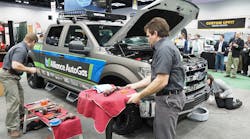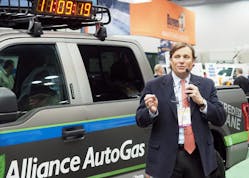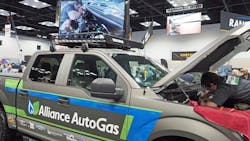In the fastest recorded alternative fuel conversion to propane autogas — indeed, beating the company's own target time by a significant margin — Alliance AutoGas technicians converted a Ford F-150 in 1:32:25 last week at the NTEA Work Truck Show.
Alliance technicians Stephen Holland and Stacey Snyder installed the company's new engineered conversion system on a bi-fuel 2016 3.5L Ford F-150 V6 nearly half an hour faster than a predicted 2 hour time; earlier expectations were for "less than 3 hours," and the company noted that typical conversions can take up to 7.
"With the installation, variability is essentially eliminated. All the components and hoses are cut specifically to length; all the bracketing is already done when the system is shipped for the conversion," Stuart Weidie, president of Alliance AutoGas, told Fleet Owner at the event. "All those components are in the package and are much easier to install, and it takes a third of the time that it used to two years ago."
Alliance's fuel system features a single-plug wiring connector and 21-gal. underbody liquefied propane gas (LPG) tank. All wiring is "plug and play" with no cuts to make, according to Alliance, and the system is bracketed and designed to be installed without drilling or fabrication. The features allow for significantly reduced labor times and conversion costs.
Weidie noted that right now, the company's top-selling conversion for fleets is for the Ford Transit van: "It's a very popular model for us, and the E-Series was popular also prior to that, and we do quite a bit with the F-250, F-350 and F-450 as well."
Fleets' savings with LPG will depend on miles driven, but "over the past eight years up until the last nine months, we averaged $1.35 less per gallon of propane than gasoline," Weidie pointed out. "Today, even with gasoline prices down considerably, we're selling propane between $0.85 and $0.90 per gallon to fleets.
"So in general, if you're driving 30,000-40,000 mi. per year — depending on the vehicle platform, mpg and your operating profile — you're going to save somewhere between $4,000 and $5,000 on an annual basis per vehicle," Weidie said.
"We are also confident in saying that fleets can experience a positive ROI with a partial asset life when reduced conversion costs are coupled with low, stable fuel prices as well as our warranty that doubles the industry standard," added Ed Hoffman, president of Blossman Services, Inc., the equipment distributor for Alliance AutoGas.
Raising awareness
In early May, the converted F-150 is scheduled to embark on a 5,300-mi. trip from Kansas City, KS, to Portland, OR, and on to Jacksonville, FL, and ultimately finishing in Asheville, NC, on May 20. The Alliance AutoGas Clean Air Coast-to-Coast Ride, supported by partners and sponsors, "will show real-time results of a cleaner, domestically produced and cost effective fuel option for fleets," according to the company.
The trip also is meant to boost public and industry awareness of propane autogas' ability to reduce carbon dioxide emissions and black carbon particulate matter.





